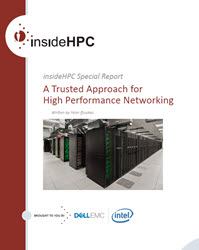This is the fifth and final entry in our series of features covering high performance system interconnect technology, HPC networking and computing. This series, compiled in a complete Guide, is focused on HPC networking trends. This entry is focused on the Dell EMC HPC Innovation Lab.
The Dell EMC HPC Innovation Lab
Every HPC workload and associated data set has specific server, storage, networking and software configuration and tuning requirements to achieve optimal performance. The Dell EMC HPC Innovation Lab, substantially powered by Intel, has been established to provide customers best practices for configuring and tuning systems and their applications for optimal performance and efficiency through blogs, whitepapers and other resources.
Another part of the lab’s charter is to give remote access to customers and partners for them to test their own codes and data sets. This can range from the selection and testing of available network technologies to fine tuning MPI libraries and other software components such as OpenHPC. This kind of capability is especially important to provide early access to newly introduced technologies such as Intel’s Xeon Phi (formerly code-named Knights Landing) or OPA networking. When combined with the ability to run real world workload-based benchmarks or bakeoffs to compare different technologies and workload profiles, it is an incomparable resource.
The lab has collaborated with a number of Dell EMC HPC Innovation Centers including the University of Cambridge, TACC, San Diego Supercomputing Center, University of Pisa and the Center for High Performance Computing in South Africa. Another example includes collaboration with the National Center for Supercomputing Applications (NCSA) on manufacturing applications detailing how to select the optimum processor models for specific manufacturing applications. Some of the results of these collaborations can be found on the Dell EMC website at the following locations: TechCenter, HPC White papers, HPC Blogs.
The Dell EMC HPC Innovation Lab is a 13,000 square-foot facility with 1300+ servers and ~10PB of storage dedicated to HPC research, development and innovation. Its engineers are meeting real-life, workload-specific challenges through collaboration with the global HPC research community and are publishing whitepapers on their research findings. They are utilizing the lab’s world-class Infrastructure to characterize performance behavior and to test and validate upcoming technologies. The lab is also an OpenHPC R&D contributor. Primary focus areas include HPC software stack; compute performance and tuning; interconnect performance and tuning; storage solutions; vertical solutions, such as genomics research and CFD/manufacturing; and proof of concept studies, including OpenStack for HPC and Hadoop on Lustre.
Dell EMC has made a major investment in two main systems dedicated HPC research and development efforts around new technologies or concepts such as the intersection of HPC and cloud or big data technologies such as Hadoop and MAP/Reduce. In addition these systems can be available to select customers to test their applications at scale with large datasets, for application benchmarking and platform characterization:
Zenith System
- Top500-class system based on Intel Scalable Systems Framework
- 13824 cores with dual Intel Xeon 2697v4 processors, accelerators, non-blocking fabric and 270TFlops sustained performance
- Expansion to 512-nodes by the end of 2016
Rattler System
- Research/development system
- 80 nodes with IB EDR and Intel Xeon 2697v4 processors
- Pending upgrade to next generation accelerators and 128-nodes
Whether the goal is to design and deliver a turnkey solution, or to provide reference architectures and information to help customers select and tune their own implementations, the knowledgebase developed by the lab, the Dell EMC HPC Innovation Centers and partners is an indispensable asset. This all supports a larger goal for Dell EMC of integrating, packaging and delivering new technologies and concepts to make HPC more accessible to more people.
For HPC, the Interconnect is the Next Battleground
Whether we are considering traditional high performance and scientific computing, real-time business analytics and big data, or the extreme scale infrastructure as deployed by Amazon, eBay, Facebook, Google or other hyperscale providers, harnessing the latest technologies is a constant challenge that gets harder every year. Optimizing the performance of these large scale clusters for critical workloads and specific data sets rather than using synthetic benchmarks is essential.
Many of the technologies used to architect these systems have become formal standards. Intel’s IA processors have levelled the playing field from the processor perspective for now, and we are very likely to see a similar scenario play out with networking technologies. It will become clear when the Intel Omni-Path Architecture delivers on its promise of successfully challenging the Ethernet and InfiniBand standards.
- The choice of interconnect is critical to application performance. An end-to-end system vendor with the resources to benchmark specific customer workloads and data on different system architectures is uniquely positioned to recommend the best configurations for each individual customer’s needs based on any and all of the leading interconnect technologies.
In a level technology playing field, the choice of trusted vendors and advisers becomes paramount. To deliver effectively a vendor needs to be able to be an honest broker and support all the appropriate technologies equally. It needs to have the resources, market presence and financial stability of an established global leader. It needs to be able to deliver currently available capabilities together with a credible roadmap aligned with future market trends. Perhaps most importantly it requires the capability to work closely with individual customers and partners to precisely match technology solutions to their specific needs and ability to adopt them. In the current business environment the shortlist of vendors that can effectively address all of those criteria is a very short list indeed.
This insideHPC Guide also covered the following additional topics on HPC Networking:
- Special Report on top Trends in HPC Networking
- High Performance System Interconnect Technology
- HPC Networking Trends in the TOP500
- Selecting HPC Network Technology
If you prefer you can download the complete report, A Trusted Approach for High Performance Networking, courtesy of Dell EMC and Intel.





